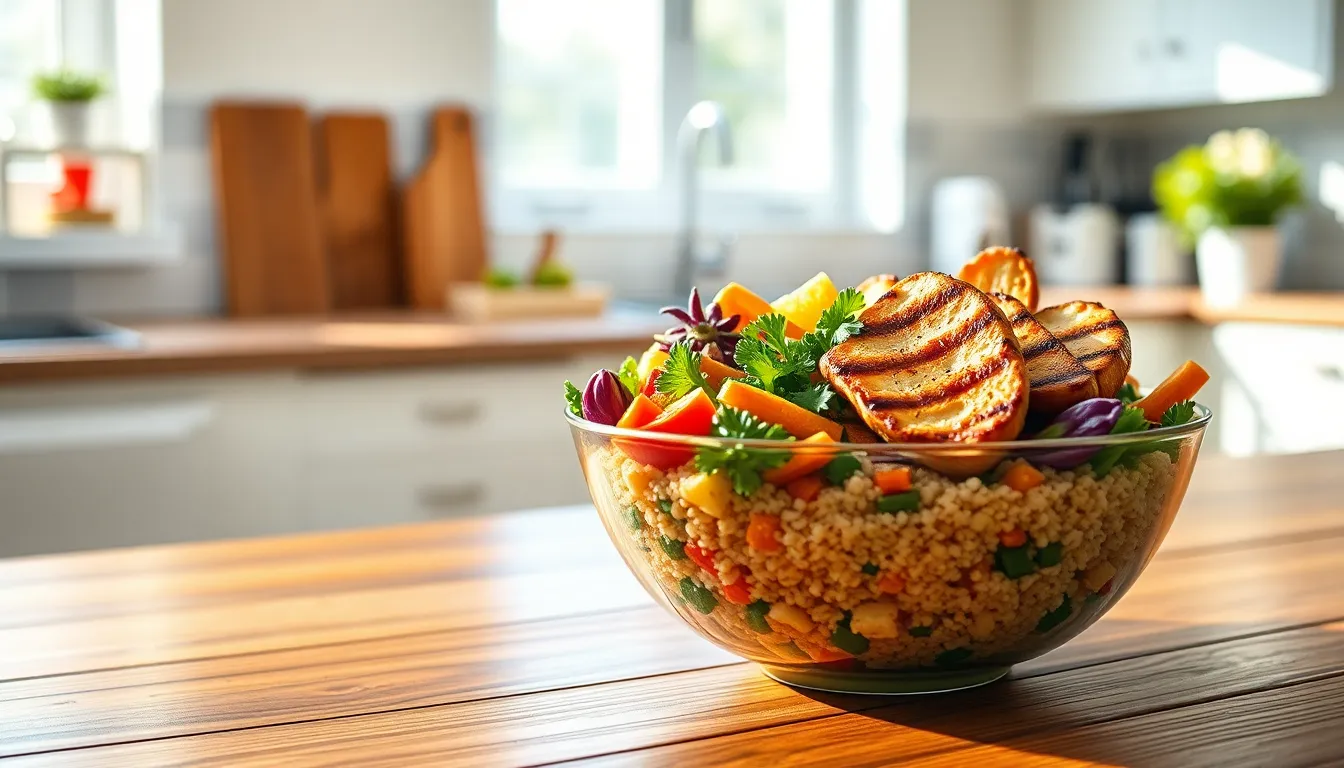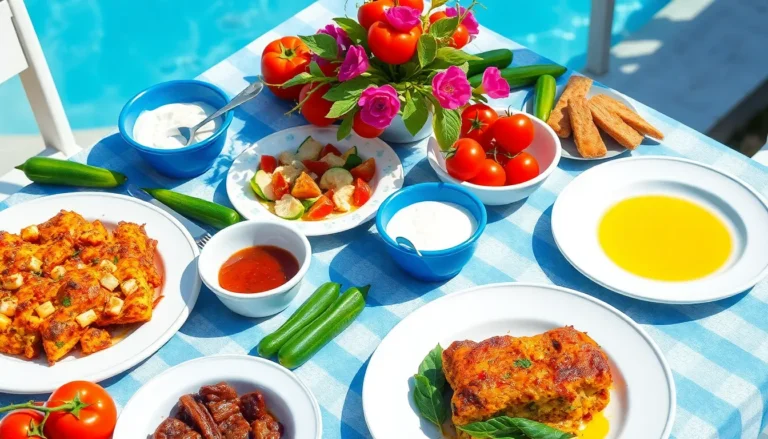Table of Contents
ToggleIn a world overflowing with fast food and processed snacks, finding the right balance in meals can feel overwhelming. A balanced diet is essential for maintaining energy levels and overall health, but it doesn’t have to be boring or bland. With a little creativity, anyone can whip up delicious recipes that nourish the body while tantalizing the taste buds.
Exploring balanced diet recipes opens up a world of flavors and textures. From vibrant salads packed with nutrients to hearty grain bowls that satisfy cravings, these dishes prove that healthy eating can be both enjoyable and fulfilling. Whether you’re a seasoned chef or a kitchen novice, there’s something for everyone in the realm of nutritious cooking. Embrace the journey to better health with recipes that inspire and delight.
What Are Balanced Diet Recipes?
Balanced diet recipes combine essential nutrients, including proteins, carbohydrates, fats, vitamins, and minerals. They offer a variety of food groups, ensuring comprehensive nourishment.
Key components of balanced diet recipes include:
- Proteins: Lean meats, poultry, fish, beans, and legumes provide the necessary building blocks for muscle repair and overall body function.
- Whole Grains: Brown rice, quinoa, and whole wheat bread provide energy and fiber, promoting digestive health.
- Fruits and Vegetables: A mix of colorful fruits and vegetables delivers vitamins, antioxidants, and essential nutrients, supporting immune function.
- Healthy Fats: Sources like avocados, nuts, and olive oil supply essential fatty acids and promote heart health.
Incorporating these elements into daily meals creates balanced options like grain bowls, salads, or stir-fries. Tasteful combinations encourage healthy eating habits without sacrificing flavor.
Benefits of Balanced Diet Recipes

Balanced diet recipes provide essential nutrients, supporting overall health and promoting well-being. These meals contribute positively to various health aspects, including nutritional value and weight management.
Nutritional Value
Balanced diet recipes are rich in essential nutrients like proteins, carbohydrates, fats, vitamins, and minerals. They ensure comprehensive nourishment, promoting better immune function and energy levels. For example, incorporating lean proteins like chicken or legumes, whole grains like quinoa or brown rice, and a variety of colorful fruits and vegetables enhances the vitamin and mineral content significantly. A diet rich in these nutrients aids in maintaining healthy skin, strong bones, and optimal organ function.
Weight Management
Balanced diet recipes support effective weight management by combining nutrient-dense foods with controlled portions. Meals featuring whole grains, healthy fats such as avocados or nuts, and high-fiber vegetables contribute to satiety and reduce cravings. For instance, a grain bowl packed with quinoa, assorted veggies, and a protein source provides sustained energy while keeping hunger at bay. Following these recipes fosters healthier eating habits, essential for achieving long-term weight goals and preventing obesity-related conditions.
Key Ingredients for Balanced Diet Recipes
Incorporating the right ingredients is essential for crafting balanced diet recipes. These key components provide essential nutrients necessary for overall health and well-being.
Whole Grains
Whole grains serve as a primary source of carbohydrates that fuel the body. They offer fiber, which aids digestion and promotes satiety. Common whole grains include:
- Quinoa: This protein-rich grain contains all nine essential amino acids.
- Brown rice: A versatile option that provides B vitamins and antioxidants.
- Oats: Known for their heart-healthy properties, oats are high in soluble fiber.
- Barley: A nutrient-dense grain that helps regulate blood sugar levels.
- Whole grain pasta: A more nutritious alternative to regular pasta, high in fiber.
Incorporating these whole grains leads to sustained energy throughout the day.
Lean Proteins
Lean proteins are crucial for building and repairing body tissues. They contribute to satiety and muscle maintenance. Notable sources include:
- Chicken breast: A low-fat protein option that provides essential nutrients.
- Turkey: Another lean poultry choice, rich in vitamins and minerals.
- Fish: Fatty fish like salmon and mackerel are high in omega-3 fatty acids, promoting heart health.
- Legumes: Beans and lentils are excellent plant-based proteins, rich in fiber and antioxidants.
- Tofu: A versatile soy-based protein, ideal for vegetarian and vegan diets.
Including these lean proteins promotes overall health and muscle growth.
Healthy Fats
Healthy fats are essential for nutrient absorption and hormone production. They play a role in heart health and inflammation reduction. Key sources consist of:
- Avocados: Packed with monounsaturated fats, they support heart health and provide vitamins E and C.
- Nuts: Almonds, walnuts, and pistachios offer healthy fats, protein, and fiber.
- Seeds: Chia seeds, flaxseeds, and pumpkin seeds are high in omega-3 fatty acids and antioxidants.
- Olive oil: Known for its heart-healthy properties, it enhances flavors in various dishes.
- Fatty fish: Also a source of omega-3 fatty acids, it supports brain health and overall wellness.
Incorporating these healthy fats ensures balanced meals that are both nutritious and satisfying.
Easy Balanced Diet Recipes to Try
Balanced diet recipes can be simple and exciting to prepare, offering a variety of flavors and nutrients. Below are a selection of easy options for breakfast, lunch, and dinner.
Breakfast Options
- Overnight Oats: Combine rolled oats with almond milk, Greek yogurt, chia seeds, and your choice of fruits. It’s a nutritious meal that’s ready to grab in the morning.
- Veggie Omelette: Whisk eggs with spinach, tomatoes, and bell peppers. Sauté until cooked through, creating a protein-rich start to the day.
- Smoothie Bowl: Blend spinach, banana, and unsweetened almond milk. Pour into a bowl and top with granola, nuts, and fresh berries for added texture and flavor.
Lunch Dishes
- Quinoa Salad: Mix cooked quinoa with black beans, corn, diced peppers, and avocado. Dress with lime juice for a refreshing and filling meal.
- Lentil Soup: Simmer lentils, carrots, celery, and onions in vegetable broth until tender. This hearty dish offers a great source of protein and fiber.
- Turkey Wrap: Fill a whole grain tortilla with sliced turkey, hummus, spinach, and shredded carrots. Roll tightly for a convenient and nutritious lunch option.
Dinner Ideas
- Grilled Salmon and Veggies: Season salmon fillets with herbs and grill alongside asparagus and zucchini. This meal provides healthy fats and essential nutrients.
- Stir-Fried Tofu and Broccoli: Cube firm tofu and stir-fry with broccoli, bell peppers, and soy sauce. Serve over brown rice for a complete and satisfying dish.
- Stuffed Peppers: Fill halved bell peppers with a mixture of ground turkey, brown rice, and spices. Bake until the peppers are tender for a colorful and nutritious dinner option.
Tips for Incorporating Balanced Diet Recipes
- Plan meals weekly. Planning meals helps incorporate a variety of nutrients and ingredients, ensuring balanced nutrition throughout the week.
- Use colorful ingredients. Incorporating a variety of colorful fruits and vegetables increases nutrient diversity, making meals visually appealing and nutritious.
- Incorporate whole grains. Choose options like quinoa, barley, or brown rice as the base for meals, providing fiber and long-lasting energy.
- Include lean proteins. Select lean sources such as chicken breast, fish, legumes, or tofu, enhancing satiety while keeping dishes healthy.
- Add healthy fats. Use healthy fats from avocados, nuts, and olive oil, which benefit heart health and absorption of vitamins.
- Experiment with herbs and spices. Use herbs and spices for flavor without extra calories, enhancing taste while keeping meals nutritious.
- Prepare in batches. Cook larger quantities of balanced recipes and store leftovers, simplifying meal preparation for the week ahead.
- Make substitutions. Replace refined ingredients with whole or less processed options, like using whole wheat for pasta or brown rice for white rice.
- Include snacks. Choose nutrient-rich snacks like fruits, nuts, or yogurt, which help maintain energy levels and prevent overeating during meals.
- Stay hydrated. Incorporate water-rich foods and drinks to support hydration, aiding digestion, and overall health.
By following these tips, anyone can seamlessly incorporate balanced diet recipes into their daily routine, promoting healthier eating habits.
Embracing balanced diet recipes is a rewarding journey toward healthier living. By incorporating a variety of colorful ingredients and essential nutrients into daily meals, individuals can enjoy flavorful dishes that nourish both body and mind. These recipes not only support overall health but also make healthy eating an exciting adventure rather than a chore.
With practical tips and easy-to-follow ideas, anyone can make nutritious meals a staple in their lives. Whether it’s a hearty grain bowl or a vibrant salad, the possibilities are endless. It’s time to take charge of one’s health and savor the benefits of balanced eating.







